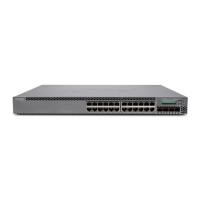CHAPTER 14
Routine Maintenance
•
Maintaining Fiber-Optic Cables in Switches on page 135
Maintaining Fiber-Optic Cables in Switches
Fiber-optic cables connect to optical transceivers that are installed in EX Series switches
and OCX1100 switches.
To maintain fiber-optic cables:
•
When you unplug a fiber-optic cable from a transceiver, place rubber safety caps over
the transceiver and on the end of the cable.
•
Anchor fiber-optic cables to prevent stress on the connectors. When attaching a
fiber-optic cable to a transceiver, be sure to secure the fiber-optic cable so that it is
not supporting its own weight as it hangs to the floor. Never let a fiber-optic cable hang
free from the connector.
•
Avoid bending fiber-optic cables beyond their minimum bend radius. Bending fiber-optic
cables into arcs smaller than a few inches in diameter can damage the cables and
cause problems that are difficult to diagnose.
•
Frequent plugging and unplugging of fiber-optic cables in and out of optical instruments
can damage the instruments, which are expensive to repair. Attach a short fiber
extension to the optical equipment. Any wear and tear due to frequent plugging and
unplugging is then absorbed by the short fiber extension, which is easier and less
expensive to replace than the instruments.
•
Keep fiber-optic cable connections clean. Micro-deposits of oil and dust in the canal
of the transceiver or cable connector can cause loss of light, reduction in signal power,
and possibly intermittent problems with the optical connection.
•
To clean the transceiver canal, use an appropriate fiber-cleaning device such as
RIFOCS Fiber Optic Adaptor Cleaning Wands (part number 946). Followthe directions
in the cleaning kit you use.
•
After cleaning the transceiver, make sure that the connector tip of the fiber-optic
cable is clean. Use only an approved alcohol-free fiber-optic cable cleaning kit such
as the Opptex Cletop-S
®
Fiber Cleaner. Follow the directions in the cleaning kit you
use.
135Copyright © 2015, Juniper Networks, Inc.

